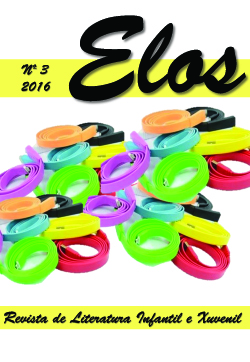The descriptive-discursive function of verbal-visuality in picturebooks
Main Article Content
Abstract
As a cultural asset, the picturebook presents complex conformation and requires the observance of some reading strategies, which can assist the mediator to capture the reader and develop his/her fruitive and interpretative competence. In contrast to the narrativity, which is preponderant in the verbal part of the text, the pictorial portion is priority regarded as descriptive. For this reason, the construction of meaning is based in inferences and affections, providing the beings and objects appreciation and the poeticity. This paper aims to problematize how picturebooks make sense, highlighting mechanisms related to descriptive-discursive function of verbal-visuality, towards the comprehension of the process of meaning-making and the contribution of reading mediators training, to make them aware of the potentialities in the text. The base theory of this article is constituted by some concepts of Semiolinguistic Theory of Discourse Analysis (Charaudeau, 2008; 2013), beyond others specific aspects of the picturebook (Nicolajeva& Scott, 2011; Linden, 2011). In order to prove the effectivity of the descriptive-discursive function, works illustrated by Graça Lima, OdilonMoraes, Nelson Cruz, MarildaCastanha and Ellen Pestilli were elected for this analysis.
Keywords:
Article Details
References
BARTHES, Roland (1990). O óbvio e o obtuso. Rio de Janeiro: Nova Fronteira.
CHARAUDEAU, Patrick (1992). Grammaire du senset de l’expression. Paris: Hachette.
CHARAUDEAU, Patrick (2007). “Uma análise semiolinguística do texto e do discurso”. In: PAULIUKONIS; Maria Aparecida Lino; ; GAVAZZI, Sigrid (orgs.). Da língua ao discurso: reflexões para o ensino. (pp. 11-29). Rio de Janeiro: Lucerna.
CHARAUDEAU, Patrick (2008). Linguagem e discurso. São Paulo: Contexto.
CHARAUDEAU, Patrick (2013). “Imagem, mídia e política: construção, efeitos de sentido, dramatização, ética”. In: MENDES, Emília; MACHADO, Ida Lúcia; LIMA, Helcira; LYSARDO-DIAS, Dylia (orgs.). Imagem e discurso. (pp. 383-405). Belo Horizonte: Fale/UFMF.
COUTO, Mia (2008). O gato e o escuro. São Paulo: Companhia das Letrinhas. Ilustrações de Marilda Castanha.
CRUZ, Nelson (2012). A máquina do poeta. São Paulo: Comboio de corda.
FRANCE, Marycarolyn (2006). Cinderela brasileira. São Paulo: Paulus. Ilustrações de Graça Lima.
GIROUX, Henry Armand (1997). Os professores como intelectuais. Porto Alegre: Artmed Editora.
GOMES, Lenice (2011). A menina que bordava bilhetes. 2.ed. São Paulo: Cortez. Ilustrações de Ellen Pestili.
HUNT, Peter (2010). Crítica, teoria e literatura infantil. São Paulo: Cosac Naify.
JAKOBSON, Roman (1974). Linguística e comunicação. 2.ed. São Paulo: Cultrix.
KRESS, Gunther & LEEUWEN, Theo van (2006). Reading images: the grammar of visual design. 2.ed. Londres/Nova York: Routledge.
LIMA, Graça (2013). O ilustrador deve ser, antes de tudo, um leitor. 22 jun 2015, http://www.fundacaobunge.org.br
LINDEN, Sophie Van der (2011). Para ler o livro ilustrado. São Paulo: Cosac Naify.
LUCINDA, Elisa (2011). A dona da festa. Rio de Janeiro: Galerinha Record. Col. Amigo Oculto. Ilustrações de Graça Lima.
LUCINDA, Elisa (2011b). Lili, a rainha das escolhas. Rio de Janeiro: Galerinha Record.Col. Amigo Oculto. Ilustrações de Graça Lima.
LUCINDA, Elisa (2010). A menina transparente. Rio de Janeiro: Galerinha Record.Col. Amigo Oculto. Ilustrações de Graça Lima.
MONDADA, Lorenza & DUBOIS, Danièle (2003). “Construção dos objetos de discurso e categorização: uma abordagem dos processos de referenciação” (pp. 17-52) In: CAVALCANTE, Mônica Magalhães; RODRIGUES, Bernadete Biasi; CIULIA, AAlena (org.). Referenciação. São Paulo: Contexto.
NICOLAJEVA, Maria & SCOTT, Carole (2011). Livro ilustrado: palavras e imagens. São Paulo: Cosac Naify.
PEIRCE, Charles Sanders (2003). Semiótica. 3.ed. São Paulo: Perspectiva.
PIROLI, Wander (2014). O matador. São Paulo: Cosac Naify. Ilustrações de Odilon Moraes.
RIBEIRO, Marcelo (2008). “A relação entre o texto e a imagem”. In: OLIVEIRA, Ieda (org.). O que é qualidade em ilustração no livro infantil e juvenil: com a palavra o ilustrador. (pp. 123-139). São Paulo: DCL.
SANTAELLA, Lucia (2005). Matrizes da linguagem e pensamento: sonora, visual, verbal. 3.ed. São Paulo: Iluminuras: FAPESP.
SANTAELLA, Lucia (2012). Leitura de imagens. São Paulo: Melhoramentos.
SANTAELLA, Lucia & NÖTH, Winfried (2005). Imagem: cognição, semiótica, mídia. 4.ed. São Paulo: Iluminuras.
TAVIN, Kevin Michael; ANDERSON, David (2010). “A cultura visual nas aulas de arte do ensino fundamental: uma desconstrução da Disney”. In: MARTINS, Raimundo & TOURINHO, Irene (orgs.). Cultural visual e infância: quando as imagens invadem a escola. Santa Maria. (pp. 57-69). Santa Maria, Rio Grande do Sul: Editora da UFSM.
ZIRALDO Alves Pinto (1983). O menino mais bonito do mundo. 13.ed. São Paulo: melhoramentos. Ilustrações de Sami Mattar e Apoena Horta G. Medina.






